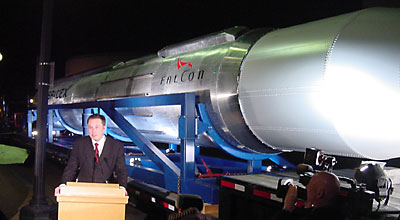The Falcon and the showmanby Jeff Foust
|
| Even jaded Washingtonians used to any variety of spectacles stopped to look at the rocket. |
Most of the few hundred people invited to the unveiling didn’t spend much time looking at the rocket, though. With temperatures near the freezing point and the imminent threat of snow, most of the invited guests hurried inside to the museum for a reception. This, arguably, was the real purpose of the unveiling: to bring together officials from NASA and the FAA, Congressional staffers, and other major players in the Washington space community, and show them what SpaceX has done in the 18 months since its inception.
During the reception Musk spoke for less than five minutes, taking much of that time to read a letter of congratulations from Congressman Dana Rohrabacher, who could not attend the event. “The history of launch vehicle development has not been very successful; there really hasn’t been a success, if you define success as making a significant difference, a meaningful difference, in cost or reliability,” Musk claimed later in his remarks. “We have a shot with SpaceX, I think, for the first time in a long time.”
For most in attendance, the end of Musk’s remarks appeared to be the last major event of the evening. Musk himself dropped no hints of major announcements during the event. “That’s it for tonight,” he said at the end of his remarks. “Be sure to take a look at the rocket on your way out.” Those who took his advice, and remained in the museum for the remainder of the evening, missed the biggest announcement of the night.
Introducing the Falcon 5
About 15 minutes after Musk finished speaking at the reception, he went outside to a podium set up by the nose of the rocket to address a handful of members of the media and others who had gathered. Those who braved the cold were rewarded. “We’re very proud to debut this vehicle, and do so here in DC,” Musk said. “Another thing I want to do here is to announce what the follow-on is to the Falcon, called the Falcon 5.”
The primary difference between the Falcon 5 and the Falcon 1, as the vehicle unveiled Thursday is now called, is in the first stage. Instead of using a single “Merlin” engine in its first stage, as the Falcon 1 does, the Falcon 5 will cluster five such engines in a longer, wider stage. The second stage of the Falcon 5 will be similar to the Falcon 1, and the Falcon 5 will sport a larger payload fairing, three meters in diameter. Like the Falcon 1, the Falcon 5’s first stage is designed to be recoverable, and hopefully reusable.
That larger first stage will give the Falcon 5 a much larger payload capability than the Falcon 1. A SpaceX document listed the capacity of the Falcon 5 at nearly 4,200 kilograms to low Earth orbit (LEO) and nearly 1,250 kg to geostationary transfer orbit (GTO). By comparison, the Falcon 1 can put less than 650 kg into LEO and has no GTO capability at all.
| Another noteworthy feature of the Falcon is its price: SpaceX plans to sell the vehicle for $12 million a flight: about $2,850 per kg, or $1,300 per pound. |
Musk pointed out two key characteristics of the rocket. “Falcon 5 will be the first US launch vehicle with true engine-out capability in over three decades, since the Saturn 5,” he said. That engine-out capability means that an engine can fail during flight without preventing the success of the mission. “We can have multiple engines fail, depending on the phase of flight, and still have a successful mission,” he said. He later said that up to three engines could fail, again depending on what part of the flight the vehicle is in. “We think that will really have a dramatic improvement in the reliability of access to space.”
The other noteworthy feature of the Falcon is its price: SpaceX plans to sell the vehicle for $12 million a flight: about $2,850 per kg, or $1,300 per pound. “It’s going to set a new world record for the cost per pound for access to space,” he said. “That’s a huge improvement over anything else.” Musk said the Falcon 5 should be available for launch in 2005. “We’re discussing first launch with a number of potential customers right now,” he said, but did not elaborate on whose those customers might be.
